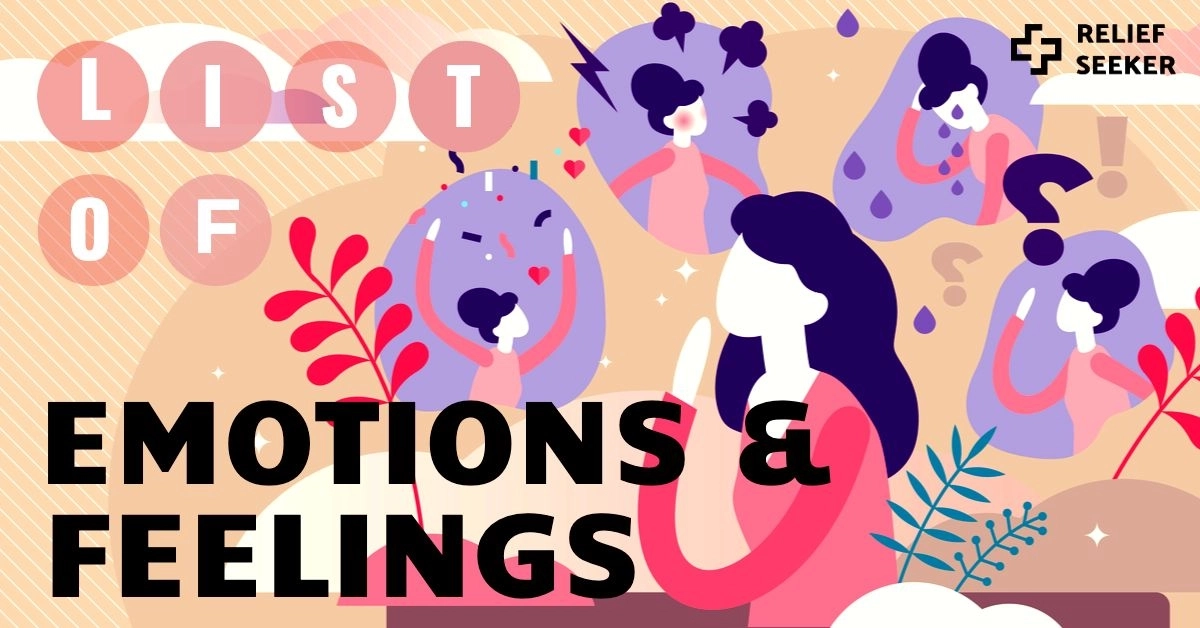Emotions and feelings can be difficult to unravel. We spend so much time trying to repress negative emotions while chasing the feel-good positive emotions that we often forget they’re all equally important.
Yet emotional intelligence can play a huge role in our happiness. People with higher emotional IQs suffer from fewer chronic illnesses and other conditions.
Add living through the COVID pandemic to the list of our daily stressors? Understanding our feelings has gotten even more difficult. Ignoring your feelings can lead to mental illness and other chronic conditions.
Referencing a list of emotions and feelings can help you determine which ones you’re experiencing. It can also help you work through your emotions and know when to let them go.
Emotion Vs. Feelings
Emotions and feelings are very similar. In fact, both your emotions and feelings can be described as happy, sad, angry, fearful, etc. The main difference between feelings and emotions is that feelings are consciously felt while emotions are subconsciously experienced.
That’s why we use the phrases, “I feel sad,” or “I’m feeling happy.” We can consciously understand our feelings.
How Are Emotions Measured?
Emotions are measured by the Differential Emotions Scale or DES-IV, which isolates 12 different emotions. The scale asks people to rate their emotions based on the number of times they felt these emotions over the past week.
This scale is similar to the Multiple Affect Adjective Check List (MAACL), and the Multiple Affect Adjective Check List-Revised (MAACL-R)
In this worksheet, we will be focusing on 9 of these 12 distinct categories of emotion.
Why Understanding Your Emotions Is Important
If kept unchecked, our emotions can run our lives. They can make our decisions for us, and we start believing our emotions and feelings are our realities.
When we admit that we’re angry, we make space between our feelings, emotions, and the truth.
Working through emotions and determining if thoughts are facts is an important cognitive-based therapy strategy (CBT). Therapists may even use emojis to help patients pinpoint how they feel at any given time (finally, a positive use of emojis!).
List of Emotions and List of Feelings
Anger
Anger is possibly one of the most striking emotions (and most basic emotions) on the wheel of emotions. We feel anger when we’re upset, frustrated, or mad. Many people often try to repress their anger, and doing so can lead to more frustration and — well, anger.
Working through anger is an important part of understanding your underlying emotions and separating your feelings from the situation's reality.
Sometimes anger can scare us because it makes us feel out of control or vulnerable.
How Do I Know It’s Anger?
Anger can pop up in seemingly strange ways. We might (understandably) become angry if we are rejected, suffer a loss, or are the victim of a crime.
Common physical attributes to anger include:
- Sudden change in body temperature
- Impaired or blurry vision (often sometimes literally seeing red)
- Shortness of breath
- Rapid heartbeat
- Tingling in the limbs
- Loss of memory
- Inability to think or speak
- Uncontrollable yelling, crying, or shaking
- Edgy or cranky feelings
Dealing With Anger
The antidote to anger is dealing with your feelings and working through them. But before you can do so, you probably need to calm your body. The following steps can help you understand your anger and create some space between its mental and physical side effects.
- Take a few deep belly breaths to lower your heart rate
- Ask yourself why you had such a striking reaction
- Try to figure out what angers you so much
- Ask yourself if you’re feeling frustrated, victimized, disrespected, or something else
- Locate where the anger lives in your body
- Mindfulness practices like meditation to bring you back to the present moment
Dealing with anger can be scary; if you don’t know how to process your feelings, we recommend contacting an online therapist to help you work through your emotions.
Disgust
Another so-called ‘negative’ emotion is disgust. The definition of disgust is “a feeling of revulsion or strong disapproval aroused by something unpleasant or offensive.”
Many of our feelings and emotions exist to help us from an evolutionary standpoint. When we see mold on rotten food, we feel disgusted, avoid eating the mold, and avoid getting sick.
Yet we can also feel disgusted about people and places too.
How Do I Know It’s Disgust?
Feelings of disgust over people, places, and things can present themselves similarly. People often report feeling sick or nauseous — even if those feelings aren’t literal. Our bodies can physically manifest these feelings, and many people report feeling disgust in their stomachs, throats, and chests.
Other ways people describe this emotion include feeling:
- Nauseous
- Repulsed
- Sick to their stomachs
- Withdrawn
If you’re feeling disgusted, you may actually pull your body backward, wrinkle your nose, or make an audible noise.
Dealing With Disgust
As with other emotions, disgust has a place in our lives! We feel it when our bodies want to avoid adverse smells, sights, and situations. Yet, sometimes we feel disgusted when we shouldn’t.
If you’re feeling this emotion about people or events that aren’t actually disgusting, you might want to take a few deep breaths and determine why you’re disgusted.
Some people have underlying feelings about sex, sexual orientation, religion, or other previously socially taboo topics.
The remedy for dealing with disgust is similar to anger:
- Take a few deep belly breaths
- Determine the reason for your reaction
- Locate where the emotion lives in your body
- Ask yourself if your instincts are valid or have led you astray
Excitement
Excitement is an emotion we often equate to positive feelings. Yet like most emotions, it can feel like a negative emotion sometimes.
Excitement can make the heart race and shorten the breath. While we feel the excitement before a big event or on vacation, its physical symptoms are similar to anxiety.
How Do I Know It’s Excitement?
Since excitement feels like anxiety, you often need to ask yourself what you’re excited about. It’s the mirror opposite of anxiety, so ask yourself if the emotion you’re feeling is a reaction to positive or negative events.
Some questions to determine if you’re feeling excitement include:
- Am I looking forward to something? Or dreading it?
- Do I feel butterflies in my stomach?
- Is my heart rate increased?
- Do I feel positive or elated at the thought of the stimulus?
- Does thinking about this feeling make me energized or depleted?
Dealing With Excitement
Sometimes excitement can feel really good. Looking forward to a vacation, graduation, or party can arouse excitement.
But sometimes it just feels like anxiety. Too much excitement can lead to insomnia, heartburn, or nerves. Excitement also pulls us out of the present and can lead to feelings of stress.
To ensure your excitement doesn’t turn into anxiety, you should:
- Practice deep belly breathing to stay present
- Ask yourself if you’re excited or anxious
- Locate the feeling in your body
- Remind yourself that there’s plenty to feel grateful about in the present
- Use your excitement to motivate positive actions in the present
Fear
Fear is another emotion we categorize as ‘negative,’ though it plays a pretty important purpose in our lives. Our bodies respond to stressors with feelings of intense fear called fight-or-flight responses.
These responses flood our bodies with chemicals that give us the strength to run really fast and ignore pain. Our parasympathetic nervous system (rest and digest system) shuts down so the body can just focus on survival.
Yet when we’re in a constant state of fear (especially over non-life-threatening stressors), our bodies can’t function properly. Fear (especially excessive fear and social phobias) can lead to excessive anxiety.
If you don’t practice stress management, you can suffer from high-risk factors of medical conditions.
Luckily, treating anxiety and fear is relatively easy, as this is a very common health condition.
How Do I Know It’s Fear?
Fear often feels like excitement and anxiety. It’s generally characterized in the physical body by an increased heart rate, shallow breathing, and confusion.
Unfortunately, our bodies respond to fear by often doing the opposite of what we need. Our good judgment flies out the window — along with our reasoning and analytical skills.
You’re probably feeling fear if you’re experiencing:
- Feelings of jumpiness or irritability
- Increased heart rate
- Shallow breathing
- Excessive nerves
- Excessive sweating or clamminess
- Inability to concentrate
- Chest pain
Dealing With Fear
Dealing with fear can be a little tricky. If you’re in mortal danger, you want to get away from that source of danger — fast. Yet, you don’t want all of your well-developed problem-solving or cognitive skills to escape you, either.
If you’re not in mortal danger, it’s equally dangerous to be in a heightened state of fear all the time. Your body can’t function properly if your parasympathetic nervous system is constantly shut down.
The remedy? Engage your parasympathetic nervous system by taking deep belly breaths, lowering your heartbeat, and use cognitive thinking skills to assess the situation.
If your fear is out of control, you can turn to modern psychiatry and get a prescription for beta-blockers.
Guilt
Guilt is another ‘negative’ feeling that has positive impacts on society. It’s the regret for something we’ve done that had a negative effect on someone else.
We hate feeling guilty about stuff. But fearing a feeling of guilt may lead us to make better decisions.
Yet sometimes, too much guilt (or fear of guilt) can actually have an adverse effect on our behaviors. If we’re so focused on feeling guilty, we can actually end up partaking in guilt-inducing behaviors.
How Do I Know It’s Guilt?
Everyone feels guilt differently. Some people feel this emotion in their stomachs, some in their chests, and some in their heads. It can manifest as migraines, nausea, or chest pains.
The symptoms of guilt include remorseful feelings, insomnia, weight management issues, change in appetite, or depression.
Dealing With Guilt
Once you’ve identified your guilty emotions, you may need to take a step back and determine if they’re valid or not.
You may want to ask yourself:
- What do I feel guilty about?
- Did I do something wrong?
- Are others suffering because of my actions?
- Am I taking on the guilt of someone else?
- How have past beliefs shaped my feelings of guilt?
Happiness Vs. Joy
Happiness and joy are two separate emotional states — though they’re often confused for each other.
Joy is more of a short-term form of happiness. We often feel jubilant when we’re scrolling through Instagram and spy photos of puppies and babies. We feel this while watching an amazing sunset. Joy can spring up when we hear a beautiful song.
Yet happiness is a little more complex than joy. It’s an emotion that’s cultivated and worked at for a long period of time.
Happiness is often the cumulation of joy in one’s life.
How Do I Know It’s Joy or Happiness?
A great example of joy vs. happiness is the difference between winning the lottery and what you do with the money.
If you were to win the lottery, you’d probably jump up and down… for joy. But if you used that money to help feed starving children, you’d probably start feeling emotions of happiness.
Dealing With Joy and Happiness
Cultivating joy and happiness isn't easy. They both take hard work and perseverance. Just like you’d work out at the gym to feel healthy and fit, you need to work at bringing more joy and happiness into your life.
Some ways to increase your joy and happiness include:
- Keeping a gratitude journal
- Starting your day with habits you enjoy
- Limiting your time on electronic devices
- Stopping to smell the roses
- Enjoying the simple things in life
Sadness
Sadness is another emotion most of us avoid. It’s the emotional state essentially classified by emotional pain. We feel it when we experience a loss or when our expectations don’t live up to our realities. Sadness can affect our well-being and health.
This emotion allows us to grieve these losses. We feel sad or heartbroken during a break-up. When a significant other leaves, it’s hard to know what to do with those feelings of love that still remain. We’re tired of feeling sad but not ready to move on yet.
Yet while sadness is often perceived as a bad thing, these feelings can also feel cathartic.
Many of us love having a good cry during a sad movie. Letting go of emotions is an important part of being human, and accepting sad feelings can help us do just that.
How Do I Know It’s Sadness?
Pinpointing sadness can be just as tricky as identifying other emotions. Sadness and depression are two feelings with similar symptoms.
To determine if you’re feeling sad, ask yourself the following questions:
- Does your body feel heavy?
- Do you find yourself crying a lot?
- Do you feel frustrated, lonely, or depressed?
- Have you recently suffered a loss?
- Have you recently experienced a change in life events? (Yes, the coronavirus counts as a life event!)
- Do your daily activities fail to bring you joy?
Dealing With Sadness
One of the most important aspects of dealing with sadness is not allowing yourself to repress these emotions. Sadness can turn to anger, bitterness, or depression if repressed.
If you’re feeling sad:
- Ask yourself where you feel the emotion in your body
- Determine the cause of your sadness
- Focus on the negative emotions and feelings in your body
- Try to work through these feelings before letting them go
- Release sadness by journaling, crying, or meditating
- Incorporate self-care and other wellness activities into your daily routine
Enlist a mental health professional's help if the feelings are too big or too overwhelming to work through on your own. Self-help can only get you so far. If your sadness is getting in the way of your daily life, you might want to get a prescription for serotonin reuptake inhibitors (SSRIs).
Self-Hostility
Self-hostility is an umbrella term for any type of self-loathing, self-hate, or any other negative emotion directed at oneself. This emotion is very valid, though we often obsess over it or feel it in excess sometimes.
How Do I Know It’s Self-Hostility?
Self-hostility is often closely linked to shame. It’s any type of negative emotion that we direct inward. If you’re feeling any of the following emotions, you may be experiencing self-hostility:
- Self-hatred
- Self-disgust
- Lack of empathy for yourself
- Unhealthy levels of remorse
- Worthlessness
- Feelings of no or little value
Dealing With Self-Hostility
Dealing with self-hostility is one of the most difficult tasks. We often aren’t good at determining whether or not our own actions are valid. If you’re dealing with these feelings, you might want to consider talking to an online therapist.
You may need cognitive-based therapy (CBT) or a combination of talk therapy and medication. Often, self-hostility is a symptom of bipolar disorder, obsessive-compulsive disorder, and/or depression.
While feeling guilt or regret is common, constant feelings of self-hostility are not.
Shame
Shame is another feeling that is difficult to unpack. Many of us feel shame over past actions we regret; some of us also feel unreasonable amounts of shame.
This emotion can rear its head at just about any time — and often catches us by surprise.
We can also feel shame about other emotions or actions that aren’t shameful. Since the rest of society generally gauges shame, we may end up feeling shameful about something simply because we’ve misunderstood the emotions of others.
For example, we might feel shame about addiction or feelings of vulnerability. While both of these behaviors are extremely normal, society generally doesn’t reward talking about either.
How Do I Know It’s Shame?
Shame is difficult to diagnose. If you’re feeling sad or anxious, you might want to pinpoint the root cause of those feelings. Are you upset about something you did or said? How would you feel if people knew the truth about things you’ve done?
Are you afraid of how others would see you if your life were an open book?
Dealing With Shame
The best way to deal with shame is by facing it head-on. But that’s easier said than done. We can often feel so much self-hostility toward ourselves as a result of shame. If feelings of shame constantly plague you, you need to ask yourself:
Are your feelings justified? Did you do or say something you need to make amends for? Or did you get some bad information about right and wrong at some point in your life?
If you’re dealing with shameful feelings, you might want to enlist the help of a professional talk therapist to work through these emotions.
Dealing with the emotions and feelings on this list isn’t easy. It’s hard to differentiate between different emotions because we often aren’t taught even to acknowledge them.
You can add this printable list to your toolkit to help you work through negative and positive feelings. If you’re struggling, we recommend finding a professional therapist to help make sense of big emotions.
Ignoring your emotions can lead to substance abuse, chronic illness, and even death. If you or a loved one is suffering from tough emotions, you may want to consider checking out therapy, anti-anxiety medications, or support groups to help you cope.


